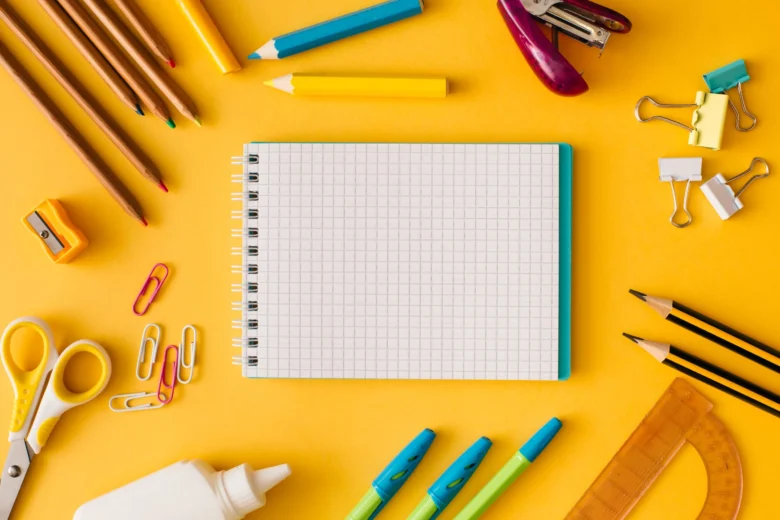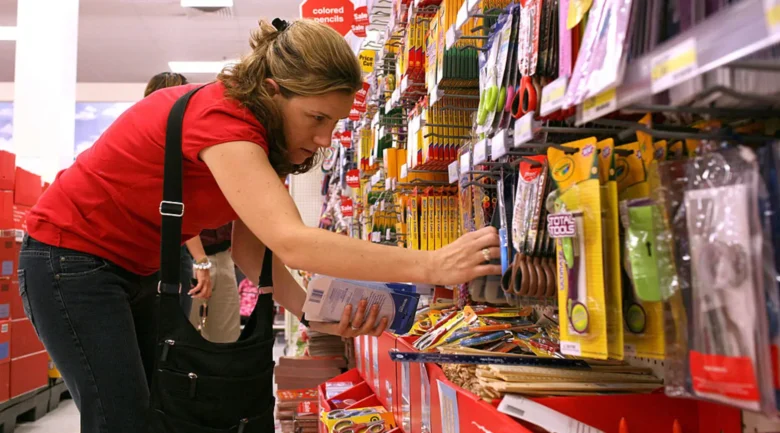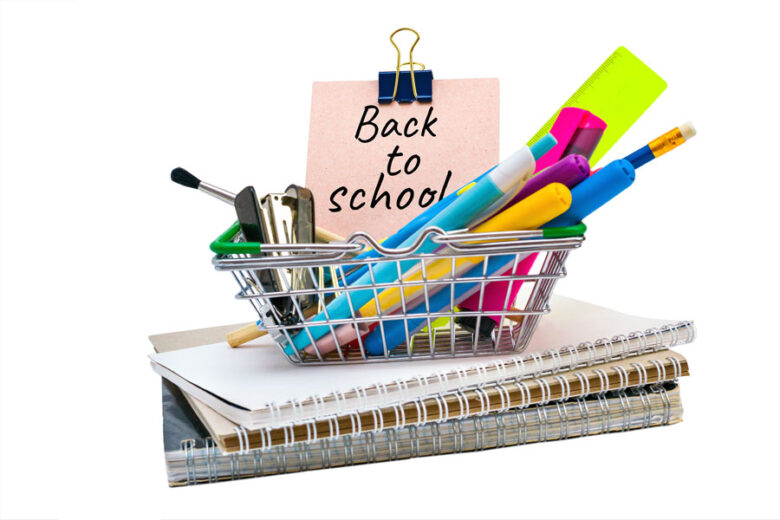It’s hard to miss the pop-up school supplies section in the front of almost every store around the end of July. It’s time for parents to grab the supply checklist and wedge a cart brimming with spiral notebooks, composition pads, calculators, glue sticks, markers, crayons, tissue boxes, shoes, and clothes through crowded isles.
Parents know the drill, but this year is a little different. In addition to long lines and out-of-stock items, they will also be contending with record-high inflation.
The National Retail Federation’s data says to expect higher back-to-school spending in 2024 than in the previous two years. The research predicts that families with kids between Kindergarten and 12th grade will spend an average of $848.90 on school items. Families with college students can expect an average cost of $1,200.32 for supplies — on top of the already high price of tuition.
A recent survey from Deloitte shows that 57% of back-to-school shoppers are concerned about inflation. Despite their worry, they remain determined to purchase needed supplies, possibly driving spending higher than it needs to be.
Research from the online discount site, CouponBirds, finds that this year’s nationwide back-to-school spending breaks down as follows:
- $11 billion on clothing and accessories
- $12.5 billion on electronic gadgets, computers, and hardware
- $7.2 billion on shoes
- $6 billion on school supplies
Fortunately, the site also has some cost-saving tips that can help parents make their shrinking paychecks go a little farther in 2024.

Source: passionatepennypincher.com
Contents
- Tip 1: Make a prioritized list of back-to-school supplies
- Tip 2: Take inventory of the school supplies and clothes already at home
- Tip 3: Don’t buy everything all at once
- Tip 4: Try to shop for used clothing and back-to-school supplies first
- Tip 5: Buy quality apparel and school supplies
- Tip 6: Take advantage of shopping on the back-to-school tax-free weekend
- Tip 7: Search for coupons and Download store apps to find discounts
- Tip 8: Buy some school supplies in bulk
Tip 1: Make a prioritized list of back-to-school supplies
Before parents hit the stores, they should create a list of everything their kids need. Items should appear from top to bottom in order of priority.
This list will be instrumental in creating a workable budget. Shopping without a plan usually leads to overspending.
Parents can print out the school’s supply list, add any clothing or shoes, and allot spending limits for each category. Bringing the list along allows them to keep track of spending as they shop.
Tip 2: Take inventory of the school supplies and clothes already at home
Many parents forget to take stock of what they already have. A quick hunt around the house is likely to turn up a box of barely-used crayons, last year’s graphing calculator, three-ring binders that can be emptied, mechanical pencils that just need new lead, a spiral notebook or two with only a few used pages, and a stash of unused notebook paper. Parents should check the items they find off their list so they know what they need when they start shopping.
In the same way, most parents will find significant savings if they take time to have kids try on last year’s wardrobe. It’s a good bet they’ve grown out of some of their clothes, but some will probably still fit. If the clothing is in good shape, it can always be passed down to younger siblings. The cost of purchasing a few items to fill out a wardrobe is far less than buying a whole new set of clothes.

Source: fortune.com
Tip 3: Don’t buy everything all at once
Parents are wise to spread the back-to-school purchases throughout the year, especially when it comes to shoes and apparel. Kids are bound to hit growth spurts, and sometimes a drawerful of jeans purchased for the coming fall will wind up being too short when cold weather rolls around.
While back-to-school sales are enticing, there are bound to be better deals on fall and winter apparel further into the season. Purchasing these items during Black Friday sales will save parents even more than picking them up in August.
Tip 4: Try to shop for used clothing and back-to-school supplies first
Many parents are seeing the benefits of buying used at local thrift shops and online resale shops. Popular stores that sell high-end clothing on the internet include:
Kids are excited about buying new, but it’s important to teach them that thrifting benefits both the budget and the planet. In addition to shoes and clothing, parents can find lightly-used backpacks, thermoses, and other supplies in thrift stores for a fraction of the cost.
For expensive electronics such as graphing calculators and laptops, buying used means massive price cuts. Online stores such as Newegg and Amazon offer professionally refurbished items right alongside the new ones.
In addition to thrift shops, garage sales and Facebook Marketplace are quick ways to search for the used supplies families need. Some parents even take matters into their own hands by organizing a neighborhood clothing swap. During elementary school, kids grow into new sizes of clothes every year. Parents can organize a fun event that saves money for everyone.

Source: si.com
Tip 5: Buy quality apparel and school supplies
Parents have all experienced buying lunchboxes, binders, and shoes that fall apart after a few weeks of use. Purchasing a quality backpack won’t save parents money the first year, but buying one that stands the test of time is the cost. Kids’ school supplies and clothing take a beating throughout the year, so winter coats or water bottles that aren’t made to handle wear and tear aren’t worth the money.
Tip 6: Take advantage of shopping on the back-to-school tax-free weekend
Once parents have inventoried the items they already have, the items they can purchase later, and the items they can find used, it’s time to hit the stores. Many states host a tax-free weekend right before the start of school. Not all items are exempt from sales tax, but the sale usually covers school supplies, apparel, shoes, and electronic devices.
The tax-free weekend always proves to be a popular shopping event. If parents don’t mind fighting the crowds, the savings are likely to be worth it.

Source: billcutterz.com
Tip 7: Search for coupons and Download store apps to find discounts
Today, most stores offer apps that notify parents of upcoming sales and send coupons straight to their inboxes. Parents can access these deals by downloading the stores’ apps or following them on social media. Before leaving the house, it’s a good idea to make a list of the back-to-school shopping destinations and sign up for savings.
Parents can save even more money on sale items by combining additional discounts from rewards or discount gift cards, including those offered from websites that parents can purchase before heading to the stores. By spending discounted gift cards on clearance or sale items, parents can actually score new clothes for less than they would pay in high-end resale stores.
Tip 8: Buy some school supplies in bulk
School supply lists are full of items that can be purchased in bulk, such as pencils, glue sticks, tissue boxes, folders, and crayon boxes. Splitting a bulk box of supplies among several kids can save a lot of money across the entire list. If parents don’t have multiple children, they might consider organizing a group of friends to share bulk items.
The power of bulk savings is one reason parents might not want to rule out the school’s pre-packed supply boxes. The items in these boxes are typically purchased wholesale, allowing schools to offer them at reasonable rates. Parents may want to do a quick price check and include the cost of their time and gas money in the equation.

Source: exploremcallen.com
When shopping for school supplies, parents have plenty of options to fight this year’s rising prices. By making a plan and sticking to a budget, they can have everything kids need this August and avoid financial stress.
